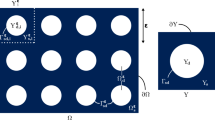Abstract
Physical mechanisms and influencing factors on the effective stress coefficient for rock/soil-like porous materials are investigated, based on which equivalent connectivity index is proposed. The equivalent connectivity index, relying on the meso-scale structure of porous material and the property of liquid, denotes the connectivity of pores in Representative Element Area (REA). If the conductivity of the porous material is anisotropic, the equivalent connectivity index is a second order tensor. Based on the basic theories of continuous mechanics and tensor analysis, relationship between area porosity and volumetric porosity of porous materials is deduced. Then a generalized expression, describing the relation between effective stress coefficient tensor and equivalent connectivity tensor of pores, is proposed, and the expression can be applied to isotropic media and also to anisotropic materials. Furthermore, evolution of porosity and equivalent connectivity index of the pore are studied in the strain space, and the method to determine the corresponding functions in expressions above is proposed using genetic algorithm and genetic programming. Two applications show that the results obtained by the method in this paper perfectly agree with the test data. This paper provides an important theoretical support to the coupled hydro-mechanical research.
Similar content being viewed by others
References
Terzaghi, K.V., Die Berechnung der durchassigkeitsziffer des Tones aus dem Verlauf der hydrodynamischen Spannungserscheinungen. Sitzungsber. Akad. Wiss. Wien Math Naturwiss, 1923, 132(2A): 105–126.
Biot, M.A., General theory of three-dimensional consolidation. Journal of Application Physics, 1941, 12: 155–160.
Walsh, J.B., Effect of pore pressure and confining pressure on fracture permeability. International Journal of Rock Mechanics and Mining Sciences & Geomechanic Abstract, 1981, 18(3): 429–435.
Kranz, R.L., Frankel, A.D., Engelder, T. and Scholz, C.H., The permeability of whole and jointed barre granite. International Journal of Rock Mechanics and Mining Sciences & Geomechanics Abstracts, 1979, 16: 225–234.
Lade, P.V. and Boer, R.D., The concept of effective stress for soil, concrete and rock. Geotechnique, 1997, 47(1): 61–78.
Nur, A. and Byerlee, J.D., An Exact Effective Stress Law for Elastic Deformation of Rock with Fluids. Journal of Geophysical Research, 1971, 76(26): 6414–6419.
Shao, J.F., Poroelastic behaviour of brittle rock materials with anisotropic damage. Mechanics of Materials, 1998, 30(1): 41–53.
Shao, J.F., Lu, Y.F. and Lydzba, D., Damage modeling of saturated rocks in drained and undrained conditions. Journal of Engineering Mechanics, ASCE, 2004, 130(6): 733–740.
Karami, H., Experimental Investigation of Poroelastic Behaviour of a Brittle Rock. 1998, University of Lille I: Lille.
Bart, M., Shao, J.F. and Lydzba, D., Coupled hydromechanical modeling of rock fractures under normal stress. Canadian Geotechnical Journal, 2004, 41(4): 686–697.
Bernabe, Y., The effective pressure law for permeability in Chelmsford granite and Barre granite. International Journal of Rock Mechanics and Mining Sciences, 1986, 3(3): 267–275.
Sun, P.D., Sun Model and Its Application. Hangzhou: Zhejiang University Press, 2002 (in Chinese).
Sun, P.D., Xian, X.F. and Qian, Y.M., Experiment study on the effective stress in coal. Mining Safety & Environmental Protection, 1999, 2: 16–19 (in Chinese).
Zhao, Y.S., Hydromechanics in Coal Rock. Beijing: China Coal Industry Publishing House, 1993 (in Chinese).
Zhao, Y.S. and Hu, Y.Q., Experimental study of the law of effective stress by methane pressure. Chinese Journal of Geotechnical Engineering, 1995, 17(3): 26–31 (in Chinese).
Feng, Z.C., Wu, H. and Zhao, Y.S., The numerical study of effective stresses law of rock mass. Journal of Tai Yuan University of Technology, 2003, 34(6): 713–715 (in Chinese).
Zhang, Y.T., Rock Hydraulics and Engineering. Beijing: China Waterpub Press, 2005 (in Chinese).
Bear, J., Dynamics of fluids in Porous Media. New York: American Elsevier Publishing Company, 1972.
Qian, J.H. and Yin, Z.Z., Geotechnique Principle and Computing. BeiJing: China Water Power Press, 1996 (in Chinese).
Yang, C.X., Evolutionary Identification of Nonlinear Material model. ShenYang: Northeastern University, 2001 (in Chinese).
Lu, Y.F., Modelisation de l’endommagement anisotrope des roches saturees in laboratoire de mecanique de lille. University des Sciences et Technologies de Lille, 2002.
Author information
Authors and Affiliations
Corresponding author
Additional information
Project supported by the Yalongjiang River Joint Fund by the National Natural Science Foundation of China (NSFC) and Ertan Hydropower Development Company, LTD (Nos. 50579091 and 50539090), NSFC (No. 10772190) and Major State Basic Research Project of China (No. 2002CB412708).
Rights and permissions
About this article
Cite this article
Zhang, K., Zhou, H., Hu, D. et al. Theoretical model of effective stress coefficient for rock/soil-like porous materials. Acta Mech. Solida Sin. 22, 251–260 (2009). https://doi.org/10.1016/S0894-9166(09)60272-X
Received:
Revised:
Published:
Issue Date:
DOI: https://doi.org/10.1016/S0894-9166(09)60272-X




